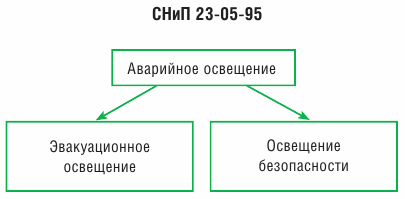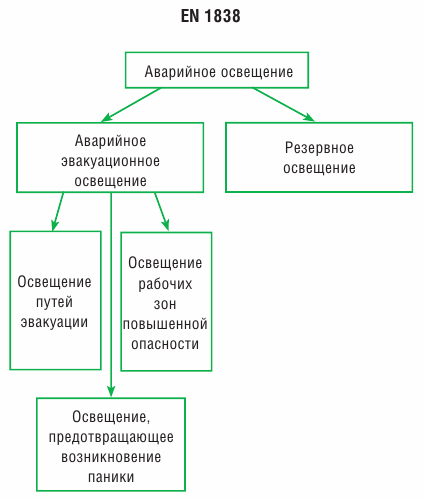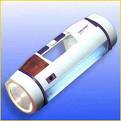Emergency lighting
Emergency lighting is the lighting that comes on when the power supply to the work lighting is damaged.
Purpose and classification of types of emergency lighting
Distinguish between emergency or auxiliary lighting on the one hand and emergency lighting on the other. Emergency lighting takes over the functions of general lighting in the event of a power failure and thus guarantees additional core work. In general, in these cases, backup power generators are used, which supply electricity to the same lamps. A minimum of 10% of the usual recommended lighting for the given activity should be guaranteed.
Emergency lighting is divided into:
- lighting for rescue routes; in order to be able to safely leave the premises, a minimum illumination of 1 lux for every 0.2 m of height is required, with a uniformity of 1:40.
- anti-panic lighting, such as minimal main lighting, which makes it possible to reach emergency exits from large rooms without problems.
- lighting for particularly dangerous workplaces (near blocks with moving parts) where, if the lighting fails, there is an immediate danger of an accident and a danger to workers' lives.
Classification of emergency lighting


Emergency lighting is divided into security and evacuation lighting.
Emergency safety lighting (emergency lighting to continue work)
 Emergency lighting should be provided in cases where the shutdown of working lighting and the related interruption of maintenance of equipment and mechanisms can cause: explosion, fire, poisoning of people; long-term disruption of the technological process; disruption of the operation of such facilities as power plants, radio and television transmission and communication centers, control rooms, pumping installations for water supply, sewage and heating systems, ventilation and air conditioning installations for industrial premises, in which the termination of work is unacceptable, etc.; violation of the regime of childcare facilities, regardless of the number of children in them.
Emergency lighting should be provided in cases where the shutdown of working lighting and the related interruption of maintenance of equipment and mechanisms can cause: explosion, fire, poisoning of people; long-term disruption of the technological process; disruption of the operation of such facilities as power plants, radio and television transmission and communication centers, control rooms, pumping installations for water supply, sewage and heating systems, ventilation and air conditioning installations for industrial premises, in which the termination of work is unacceptable, etc.; violation of the regime of childcare facilities, regardless of the number of children in them.
Evacuation lighting in premises or in places where work is carried out outside buildings, it must be provided: in places dangerous for people to pass through; in the paths and on the stairs, which serve to evacuate people, when the number of evacuees is more than 50 people; on the main paths of production facilities in which more than 50 people work; in the stair signs of a residential mania with a height of 6 or more stories; in industrial premises with constantly working people, where the exit of people from the premises during an emergency shutdown of normal lighting is associated with the risk of injury due to the continued operation of production equipment; in the premises of public and auxiliary buildings of industrial enterprises. if the premises can accommodate more than 100 people at the same time; in industrial premises without natural light.
Safety lighting must create on working surfaces in industrial premises and on the territories of enterprises that require maintenance, when the working lighting is turned off, the lowest illuminance in the amount of 5% of the lighting standard for working lighting from general lighting, but not less than 2 lux in buildings and not less than 1 lux for the territories of enterprises. At the same time, the creation of the smallest lighting in buildings with more than 30 lux with discharge lamps and more than 10 lux with lamps with filament is permitted only if there are appropriate justifications.
Emergency evacuation lighting
 Evacuation lighting should provide the lowest illuminance on the floor of the main paths (or on the ground) and on the steps of the stairs: indoors — 0.5 lux, outdoors — 0.2 lux.
Evacuation lighting should provide the lowest illuminance on the floor of the main paths (or on the ground) and on the steps of the stairs: indoors — 0.5 lux, outdoors — 0.2 lux.
The unevenness of the evacuation lighting (the ratio of the maximum illumination to the minimum) along the axis of the evacuation passages should be no more than 40: 1.
Interior emergency lighting fixtures can be used for evacuation lighting.
In public and auxiliary buildings of enterprises, exits from premises where more than 100 people can be at the same time, as well as exits from production premises without natural light, where more than 50 people can be at the same time. or with an area of more than 150 m2, must be marked with signs.
Exit indicators can be light, with built-in light sources connected to the emergency lighting network, and not light (without light sources), provided that the exit indication (inscription, sign, etc.) is illuminated by lamps for emergency lighting.
In this case, the indicators must be installed at a distance of no more than 25 m from each other, as well as at the bend of the corridor. In addition, exits from corridors and entertainment adjacent to the premises listed above must be marked with signs.
Lighting devices for emergency lighting (emergency lighting, evacuation) can be ignited. switched on at the same time as the main lighting devices with normal lighting and not illuminated, automatically turn on when the power supply with normal lighting is interrupted.
Security lighting (in the absence of special technical means of protection) must be provided at the borders of territories protected at night.The illuminance must be at least 0.5 lux at ground level in the horizontal plane or at a level of 0.5 m from the ground on one side of the vertical plane perpendicular to the boundary line.
When special technical means of protection are used, the lighting must be taken according to the assignment for the design of protective lighting.
Any light source may be used for emergency lighting, except where the emergency lighting is normally off and is automatically turned on by the action of a security alarm or other technical means. In such cases, incandescent lamps should be used.
Currently, in our country, the requirements for lamps and emergency lighting systems are regulated by a number of normative documents, the most important of which are:
- GOST R IEC 60598-2-22-99: Specific requirements. Luminaires for emergency lighting;
- NPB 249-97: “Lamps. Fire safety requirements. Test methods ";
- SNiP 23-05-95: «Natural and artificial lighting». Section "Emergency lighting", clauses 7.60 — 7.68;
- PUE 7th edition. Chapter 6.1 "Emergency lighting", clauses 6.1.21 — 6.1.29.
The first two documents regulate the requirements for a luminaire for emergency lighting as an electrical device, the other two give the classification of emergency lighting, describe the rules for placing lamps, connect to the power supply and provide the standardized characteristics of emergency lighting.
In 1999, the European Committee for Standardization in Various Industries (CEN) developed European standards EN 1838 "Applied lighting technology. Emergency lighting ".Below is a summary of the documents establishing the lighting standards for emergency lighting: SNiP 23-05-95 and EN 1838.
See also: Emergency lighting schemes
